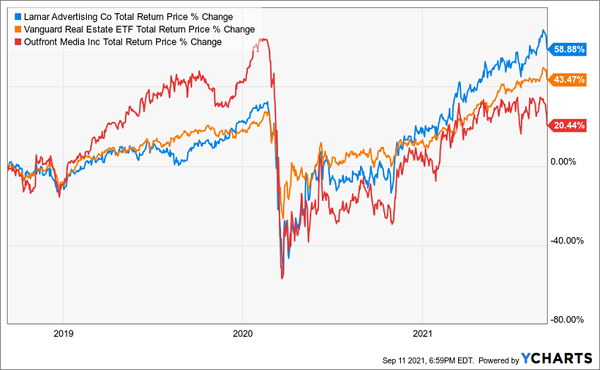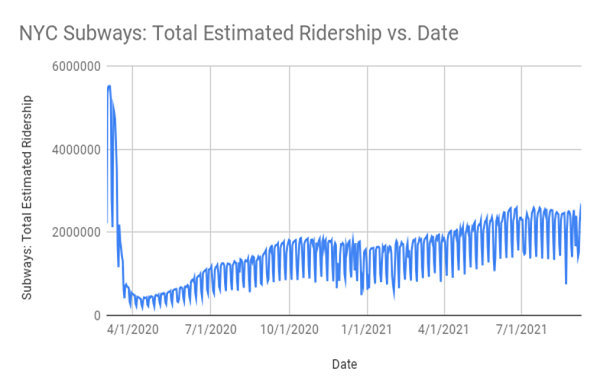Editor’s Note: There’s still time to sign up to Adam O’Dell’s Wednesday Windfalls live event. To sign up, click here. On Thursday at 4 p.m. Eastern time, Adam will finally reveal the details of his new strategy that’s beat the market by 51 times … don’t miss it.
I’m someone that pays close attention to my surroundings.
My wife calls me “attentive,” and I think it’s a fair assessment given my analytical background.
There’s one thing that always seems to capture my attention.
It’s those giant, bright, colorful shiny billboards that sit on top of every single highway in America.
Ask my wife, and she will tell you about the time that I nearly drove our RAV4 into a pickup truck on Interstate 93 in Boston.
We were heading back from a rural wedding in New Hampshire and only a few miles from home.
And there it was — a half-naked, dinosaur-sized photo of Anna Kournikova (the former tennis player) advertising something … maybe it was Nike or some liquor, I can’t quite remember.
I was too focused on the specter of one of my hall passes hanging over my dashboard.
I called the State Police that week to see if the accident totals in Boston had somehow increased, and they sounded like they wanted to commit me.
So….the moral of the story?
Those highway billboards can be pretty seductive.
The good news is that investors can tap into this seduction; two publicly-traded REITs have cornered over half of the U.S. billboard market.
Let’s dig in.
Billboard REIT No. 1: Lamar Advertising
Dividend Yield: 3.7%
Lamar Advertising Co. (Nasdaq: LAMR) is the out-of-home (OOH) advertising king with a 20% market share. LAMR generates nearly 90% of revenues from billboards, with a smaller percentage from other in-your-face ads you might see in local train stations or airports.
I’m not sure if it was the ones responsible for that Anna Kournikova billboard, but it’s highly likely; the company has over 120 years of operating experience with over 40,000 tenants and 170,000 billboards.
Some of the world’s biggest companies leverage these billboards to get your eyeballs on their products. The five biggest OOH advertisers last year? Apple, McDonald’s, GEICO, Amazon and HBO.
And here’s a secret about the billboard advertising market; once you have the rights to a particular billboard location secured, it’s like finding gold at the end of the rainbow.
The reason? Permitting restrictions on billboards are very, very restrictive. Not everyone wants a massive 700 square foot intrusion disrupting their everyday lives. So, once you get it, you have it, but trying to get it is a big challenge.
The shift to digital billboard advertising is a significant change, and LAMR is at the forefront of growing its digital footprint. Of LAMR’s 170,000 billboards, only 3,600 (roughly 2%) are digital. Yet, these digital billboards provide approximately 25% of overall revenues!
Think about the digital billboards you’ve driven by on the highway and how frequently they change with different advertisements.
Digital billboards are much more profitable, but conversions are both time-consuming and challenging from a regulatory perspective.
Thus, LAMR is keen to stick to a conversion rate of 250-300 billboards a year.
LAMR is, of course, in the advertising biz, so there were some pandemic-related effects early on. However, revenues have recovered and are now above pre-pandemic levels.
LAMR has outperformed competitors for one, due to their lower exposure to airport and transit advertising, which hasn’t seen as quick of a pandemic-related recovery in the same way that billboards have.

I think LAMR is an excellent opportunity for anyone that wants to play into the continued digitization of outdoor billboards. Not only is there an opportunity for capital appreciation here, but the company also offers an above-industry 3.7% dividend yield, which had been growing consistently at around a 10% clip pre-pandemic.
Billboard REIT No. 2: Outfront Media
Dividend Yield: 1.8%
If LAMR is the granddaddy of the U.S. billboard ad market, Outfront Media Inc. (NYSE: OUT) is one of the grandkids, with a smaller but impressive footprint of roughly 47,000 billboards (about 1/4 the total of LAMR).
OUT also has a higher percentage of revenues generated from transit-based advertisements (roughly 1/3 of overall revenues), which have seen sluggish demand, as work-from-home trends have impacted ad budgets targeting public transportation.
In addition, OUT has a national-based focus compared to LAMR, with 42% of billboard revenues generated from big advertisers like Budweiser or Pepsi. LAMR has a more targeted, localized focus, appealing to nearby retailers or restaurants. This localized approach tends to be more immune to any wide economic swings.
Still, OUT is making the same digital advertising transitions as LAMR, with nearly 200 digital billboards expected for conversion this year.
However, because of OUT’s high transit-based advertising exposure (especially in NYC), the stock has lagged LAMR. Yet, there are signs of improvement. Although NYC transit ridership is still over 50% below pre-pandemic levels, it has been ticking up.

This improvement in mobility is good news for OUT, and correspondingly, the latest earnings results showed signs of life for their transit ad business, with revenues expected to grow by 70% in the third quarter.
Thus, value-conscious investors might consider OUT as the turnaround play in the billboard REIT space due to their leverage to big, national advertisers and transit-based advertising. OUT certainly has been priced at a more attractive value; it trades at just 14.3-times AFFO, well below LAMR, which trades at 16.4-times.
OUT does, however, offer a lower yield of 1.8%, so I’d consider LAMR (3.7% yield) if you would prefer to clip a higher coupon.
To learn more about generating monthly dividends as high as 8%, click here.



